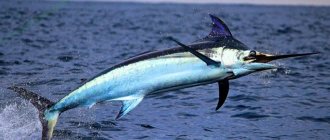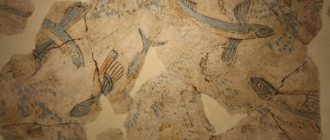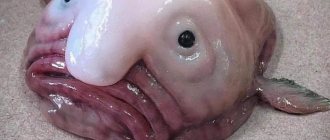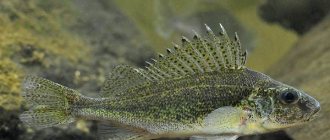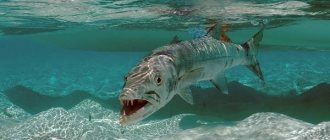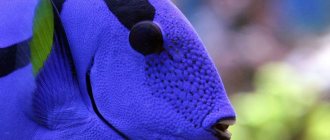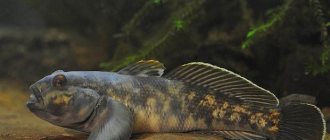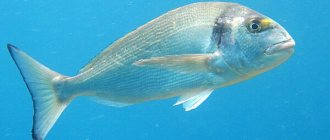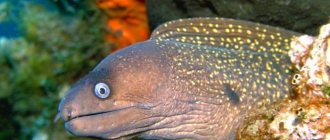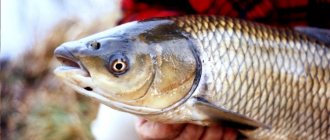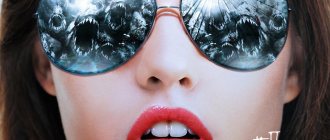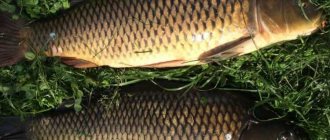Classification
| Type: | Chordata |
| Class: | Ray-finned fish |
| Squad: | Scorpiformes |
| Family: | Psycholuteaceae |
| Genus: | Psycholutes |
| View: | Psychrolutes marcidus |
| Scientific name: | Psychrolutes marcidus |
Photo: fish drop under water
General description and origin of the name
The drop fish belongs to the order of scorpionfishes. The closest relatives of this unusual creature are Cottunculi, Neophrynychts and Soft Gobies.
The fish got its Latin name Psychrolutes marcidus because of its habitat - it is found at great depths, where the water temperature is very low. And psychrolutes is precisely translated from ancient Greek as “lover of cold baths.”
The fish received its Russian name, like the English blobfish, due to its appearance - this representative of the chordates really resembles a liquid, gelatinous drop. The English call this psycholute toadfish, and in Australia the common name is Australian goby.
Photo of jelly-shaped blob fish
For the first time, fishermen raised this unusual creature from the depths of the Pacific Ocean in 1926, but due to insufficiently developed technologies, it was not possible to study the deep-sea inhabitant well. The Australian goby gained worldwide fame in 2003, when one of the representatives of this family was caught off the coast of New Zealand by ichthyologists carrying out a research voyage.
Appearance
The sea creature owes its name to its appearance, since it resembles a large droplet in body structure. From a distance it seems that this is an ordinary fish, but closer to the tail there are small outgrowths that are comparable to spikes; by these you can identify an ocean goby.
Fleshy lips and a healthy head occupies most of the body, like most deep-dwelling inhabitants, then smoothly passes into the tail. Her dark eyes are set deep, and on her face there is a growth that vaguely resembles a human nose. If you look at the “face”, it will look like a dissatisfied physiognomy, as if someone had offended him, this became the reason for the appearance of another name - “sad fish”.
Features of the structure of fish drops
The sea fish differs significantly from typical sea inhabitants in the complete absence of bones and scales. Of course, some species are also deprived of scales, but the drop fish even lacks muscles, and behind them developed fins. It can grow up to 70 centimeters in length, and its maximum weight reaches 14 kilograms.
Since fish live mainly on the bottom of the sea, they have to endure enormous pressure. She succeeds in this due to the structure of her body, which resembles jellied meat or something jelly-like. The density of this mass is almost equal to the density of water. The fish also lacks an air bladder.
What color is a drop fish?
Juveniles are predominantly dull pink, but adults change color to grey-brown. The eggs that the female lays during the breeding process are also pink.
Fish drop in water
What does a drop of fish look like underwater?
As contradictory as this may sound, in a comfortable environment it looks like an ordinary fish. It's all about pressure, relative to sea level, it can be more than 100 times greater. It is impossible to see the fish live in its natural environment, but many artificial conditions were simulated, on the basis of which it was possible to create approximate visualizations of the ocean goby.
Photo: Fish drop under water
What does a drop of fish look like on land?
The appearance of the fish on land can be compared to jelly; it spreads and looks quite funny. This is due to the difference in pressure on land and in the ocean. A funny little nose forms on her face, which makes her want to call her a brat.
Characteristics and description
The drop fish belongs to the psycholute family of the class of ray-finned fish. It is also called toadfish, Australian goby, and psycholute goby.
The existence of the species first became known at the beginning of the last century. Since studying the blobfish in its natural habitat is associated with significant difficulties, scientists still do not have complete information about its habits and lifestyle.
It is believed that psycholutes live alone, remaining in the same territory for a long time. The area occupied by one adult individual is within 2-3 square kilometers. Fish that have reached sexual maturity can form pairs during the breeding season.
Structural features
A long stay at great depths had a definite effect on the structure of the body. Distinctive features of drop fish include the absence of cartilage and bones. In addition to the fact that psychrolutes do not have a skeleton, they also have practically no developed muscles and no air bladder.
The body of the drop fish resembles a jelly-like mass. Its density is somewhat less than the density of water at a depth of 800-1000 m. This body structure allows it to move freely in the bottom layers. The fins do not serve to give the fish speed, but to maintain balance and change the direction of movement.
The vision of the blob fish is also adapted to life at great depths. The light sensitivity of her eyes, due to a certain ratio of cones and rods in the retina, is much higher than that of a person: while the human eye ceases to distinguish light at a depth of 500 m, the psycholute continues to use vision for orientation at a depth of 1000 m and below.
Origin theory
Psycholuteidae, to which the Australian goby belongs, is part of the subfamily of slingshot-like fish. Some species in the process of development acquired a certain similarity with lipar, or sea slugs.
Research indicates that the first slingshot fish appeared in the Sea of Okhotsk. They subsequently spread throughout the western Pacific Ocean and are now found in both the Northern and Southern Hemispheres.
Since psycholutes are of northern origin, in warmer ocean waters they descend to the maximum depth, where the least heated water layers are located. It was this feature that became the key when choosing the species name: translated from Latin, Psychrolutes means “bathing in cold water.” The fish began to be called a drop because of the characteristic shape of its loose gelatinous body.
The first specimens of the Australian goby were caught almost a hundred years ago. Before this, residents of coastal areas occasionally found deformed bodies thrown out on birch trees, but it was impossible to identify and study the half-decomposed remains.
It was possible to classify the drop as a separate species and partially study it only in the middle of the last century. Research became possible thanks to the advent of devices that make it possible to descend to great depths. At the same time, today psychrolutes continue to remain one of the least studied species, since all data about it is obtained from a few underwater surveys and analysis of the body structure of caught individuals.
What does it look like
In their natural habitat, drop fish are practically no different from ordinary fish and have a certain similarity with gobies.
Among the external features of the species are the following:
| Body | Flattened laterally and tapering towards the tail |
| Head | Large, rounded, with wide-set eyes and a large mouth, length reaches 60% of the total body length |
| Fins | In the upper part of the body there is a solid dorsal fin, immediately behind the head there is a pair of small pectoral fins, the caudal fin is not divided into blades |
| Leather | Smooth, has no scales, young individuals have small growths that later disappear |
| Color | In fry, the skin is white with a pinkish tint; with age, the color changes to gray or light brown |
As it rises from the bottom to the surface, the appearance of the blob fish changes noticeably. This happens due to a sharp change in pressure. The fish is adapted to life at depth, where a column of water presses on it with a force that is 60-100 times greater than on land. As a result of the decrease in pressure, the body of the drop is susceptible to decompression damage, acquiring a rather ugly appearance.
Typically, psycholutes have swollen lips, the corners of which move downwards, and the size of the growth above the mouth increases. The growth forms a thickening that looks like a nose. The body of the Australian goby floats and turns into a shapeless mass with barely noticeable small fins. As a result of these changes, the blob looks like a fish with a large nose and a sad expression similar to a human face.
How many years does he live?
Presumably, the average lifespan of a drop in its natural habitat is 8-10 years. There are currently no more accurate confirmed data on the maximum age of a psycholute.
OCTOPUS
History of discovery
In 1926, Australian fishermen in the state of Tasmania, on the island of the same name, caught a drop fish for the first time. The catch left the fishermen confused. Since the type of capture could not be determined, they decided to transfer the first specimen to scientists.
The creature was classified and then forgotten. The reason for this was the lack of necessary equipment to study the new species, since it lives at a sufficient depth. Research continued with the first appearance of deep-sea vessels, which occurred in the second half of the 20th century.
Until this time, fishermen continued to catch monstrous fish on the Australian and Indonesian islands, but the scientific side did not take part in their study, since the caught specimens were not suitable for study.
Technological progress and mechanical fishing trawlers, which are capable of stretching a net at great depths, made it possible to catch living individuals, and they, in turn, were already suitable for study.
Habitats
The Indian, Pacific and Atlantic Oceans are the main habitats of the drop fish. Sometimes it approaches the coasts of Australia, but usually stays at a depth of about 1000 meters. Despite the fact that its habitat is the southern oceans, it can be concluded that it is cold-loving, since such depth is accompanied by very low temperatures.
An interesting fact is that at such a depth there is pitch darkness, which means the drop was able to adapt to life in such conditions.
Is it possible to observe blobfish in the wild?
The drop fish lives exclusively in the wild. It cannot be kept in aquariums because it is difficult to create the necessary conditions regarding water pressure in captivity.
It is impossible for a person to meet a “brat” in nature. For now, he cannot descend to the depths where psychrolutes live, and they themselves do not intentionally rise above 600 m.
Poor knowledge does not allow specially catching fish and breeding them on the surface.
Behavior and lifestyle
The psychrolut goby is not particularly active; it prefers to be sedentary; due to the lack of developed fins, it is not suitable for performing fast maneuvers under water pressure, but active mobility is precisely not needed there.
Since it is not possible to study the species completely in the depths of the ocean, scientists conclude that mostly adult individuals prefer solitude and come together only to reproduce. This interesting fish is a connoisseur of personal space; it rarely swims outside its native territories; this can be influenced by currents or external factors, for example, commercial fishing.
However, one day there comes a time when Pisces have to break their loneliness and find a mate to continue the family line. This period begins as soon as the female is ready for fertilization. No dependence on the time of year was identified, possibly due to the fact that this species has been practically unstudied.
Edible or not?
In European opinion, drop fish is considered inedible due to the fact that, strictly speaking, there is nothing in it. It has no muscles, and therefore no meat that can be stewed or fried. Her body is a gelatinous mass. However, Asian amateur gourmets still eat it and even consider it a delicacy. The fish is not commercial in the broad sense of the word. It most often ends up in trawl nets by accident when fishing for other deep-sea “seafood”. Local sailors sell it as a souvenir, however, Asian restaurants are increasingly buying it for preparing gourmet dishes, and it is not cheap. In Europe, the “delicacy” is still treated coldly.
What does drop fish eat?
The diet of offended fish is not particularly varied, since at a depth of 1000 meters or more there are significantly fewer marine inhabitants. Fish mainly feed on:
- small crabs, shrimp;
- shellfish;
- sea urchins;
- plankton.
The fish obtains food in a passive mode, that is, it waits until the prey itself swims into its mouth. There is an assumption that due to the small variety of food at depth, the animal does not always find enough food, and the method of extraction allows saving energy.
Lifestyle and nutrition
The thickness of the water makes this fish more frightening
The blobfish is endemic and lives only off the coast of Australia at depths from 500 m to 1500 m. The density of the fish is slightly less than the density of water. Thanks to this, the sea monster can swim without a swim bladder, which is present in almost all other fish. At great depths, the pressure is so strong that the gas begins to liquefy, that is, it loses its properties.
She moves very slowly. This is due to underdeveloped muscles, which do not allow the fins to create the necessary impulse for jerking to swim. However, the low density of the body, compared to water, and underwater currents move the monster in the lower layers right at the bottom. The fins only help to correct the direction of movement. It turns out that she seems to be gliding in the water, without spending any energy on it.
Natural enemies
The waters in which the sad fish live have few predatory representatives ready to feast on it. The greatest danger to the psycholute family comes from:
- giant squid;
- deep sea octopuses;
- angler fish;
- and some other deep-sea predators.
The main threat to sad fish is the human factor. The species itself is not valuable to people, but vessels that catch fish for the purpose of sale quite often catch a drop along with other fish.
Lifespan and natural enemies
In its natural environment, a blobfish can live 5–9 years. In addition to lack of food, natural enemies influence the decrease in the population of these individuals.
In the deep waters where the blobfish lives, there are not many predators that can eat it. Ichthyologists suggest that the greatest danger from the animal world to psycholutes is:
- giant squid;
- angler fish.
Also, the enemies of the drop fish are deep-sea octopuses and other fish that are not averse to eating the caviar of the Australian goby.
The giant squid is a natural enemy of the blobfish
But still, the main enemy of this unusual, jelly-like fish is man. For most people, the Australian goby itself is of no value, but people catch crabs and squid from the ocean floor with deep-sea trawls for commercial purposes, and with them the clumsy blob fish is caught in the net.
Trawling of crabs is the cause of death of the blob fish
Is it possible to eat drop fish?
This deep-sea inhabitant cannot live on the surface of the sea for even a few hours, so it becomes a wasted victim.
The taste qualities of drop fish have been little studied; you won’t see it on the menu in European restaurants, since Europeans consider the meat of these psycholutes to be completely tasteless and inedible.
But residents of Asian countries (mainly China and Japan) have a different opinion: the Australian bull is considered a delicacy and is sold for a lot of money. Probably, the inflated cost is not due to the unusual taste, but to the rarity of this species.
INTERESTING FACT . In 2022, a randomly caught blob fish hit the shelves of a Sydney fish market. Market worker Alex Shtollnov bought it and fried it at home with a blowtorch. According to him, the fish tasted like lobster meat.
Drop fish - a delicacy of Asian cuisine
Reproduction and offspring
The drop fish is considered the most caring species among other fish, since they try to raise their offspring in warmth and care until a certain age.
Scientists have not been able to understand how the blob mates or how the male looks for a potential female, but it is known that the sad fish hides its eggs in the sand. Then she covers the future bulls with her body and hatches the offspring.
After the small fish are ready for independent life, they look for a suitable place and living conditions for themselves, where there will be enough food to survive.
Reproduction
During their solitary life, adult individuals at certain periods begin to unite and create pairs. This occurs during fertilization and the creation of offspring. Scientists have not fully elucidated the characteristics of this period in Australian carp. It is known that females lay eggs at the bottom, in those places where they constantly live.
After this, the fish begins to protect its offspring so that they are not touched by more predatory inhabitants of the ocean. She sits on the eggs and waits for the fry to appear. After this, the female helps the fish get comfortable in deep water areas and provides them with proper safety.
After the appearance of small fish, the family prefers to stay in more remote and secluded places so as not to arouse the interest of predatory inhabitants. When the fry grow up, all the fish spread out to the sides and try to find a suitable habitat for themselves.
Population and species status
The sad blot does not have many enemies, but the population is rapidly declining.
Main reasons:
- industrial waste and garbage that people throw into the ocean, and then they settle on the bottom;
- poaching and industrial fishing on a huge scale, the drop is not considered a valuable species, but is caught in nets;
The population of drop fish grows slowly enough to double, they need a period of 5 to 14 years. If we continue to turn a blind eye to the human factor, this species will soon disappear from the planet.
If the media continues to report on the possible consequences, it may help save the ocean goby from extinction.
Species population size
Although members of this family are still little studied (primarily due to the high cost of deep-sea diving), the blobfish is considered to be an endangered species. There are three main reasons for the decline in the number of these individuals.
- Lack of food in the deep ocean.
- The death of fish from the influence of various wastes accumulating on the bottom of the seas.
- Raising of the Australian goby to the surface in nets as a result of fishing.
Ichthyologists have calculated that it will take at least 10–15 years to restore the species. Due to the threat of complete extinction of representatives of this family, targeted fishing of drop fish is prohibited.
Among other things, an unfavorable factor for this species is the increase in water temperature of the entire World Ocean (remember, the blobfish is an inhabitant of cold waters).
Interesting facts about the proboscis
Here are facts about the drop fish that will help you learn more about its lifestyle and habitat, and also tell you some of the surrounding secrets.
No skeleton or muscles
It was called that because when this strange fish was caught, the name completely corresponded to its appearance. The fish received the name drop due to the lack of a full skeleton and bones.
This animal still has muscles, but they consist of a jelly-like substance. This body structure is necessary for a drop to survive under the enormous pressure of the ocean.
Doesn't always look like a drop
It is surprising that the natural habitat causes the ocean goby to change in appearance. Under great pressure, it can be confused with an ordinary fish, only if you carefully look at the face and growth on the body, the drop can be recognized.
Where does it live?
The Australian goby is a deep-sea fish. They live at a depth of more than 600 m. Due to the special structure of the body, drop fish cannot rise above this level.
Researchers do not have accurate data on the species’ range. It is now generally accepted that the drop is found in the waters of the Bass Strait, which separates the Australian continent and Tasmania, as well as near the coast of New Zealand. It was here that the largest number of individuals were caught.
The northern part of the Pacific Ocean is also considered its habitat. It is quite possible that psychrolutes are also common in other parts of the World Ocean, but there is no confirmation of this fact yet.
